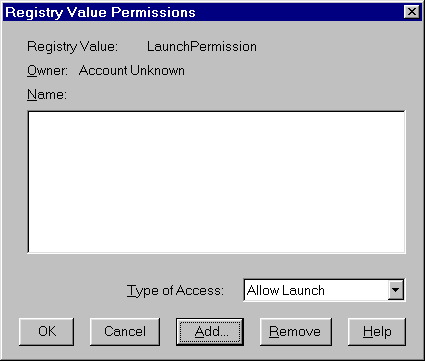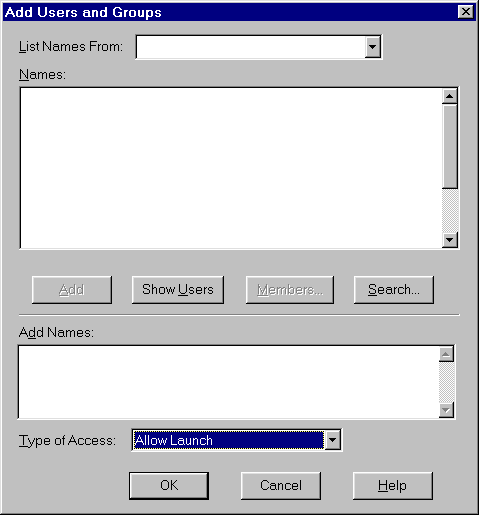|
|
COM/DCOM
To grant permissions to users and groups specifically for accessing and launching the SAS server
(instead of defining global permissions as shown in the previous section):
From the Windows taskbar, click Start  Run. Run. Type dcomcnfg and click OK. The Distributed COM Configuration Properties window appears. - Select the Applications tab:

This tab shows the AppID description for each DCOM server that can be run on your machine.
(The AppID GUID is shown for servers that register without a description.)
Locate the IOM server that you are configuring and select it. For example,
if you want to set policies for the Workspace, select SAS.Workspace (SAS
Version 9.1. The application listing differs depending on which version
of SAS is installed. See AppIDs for Configuring DCOM
to determine which AppID to look for. After you highlight the selection, click on the Properties button. The Properties dialog box for the server object appears. Select the Location tab.

Check the default location setting. By default, the only option enabled is Run application on this computer, as shown in the illustration. No other
options are required for SAS applications. Select the Identity tab.

Select the identity based on the type of server:
- For multi-user servers (SAS Metadata Server, and the SAS System 9 OLAP server),
select This user and specify the User, Password, and Confirm Password
information.
CAUTION: Support for the use of COM in the SAS Metadata Server is
experimental in SAS 9.1. Do not use COM in the SAS Metadata Server
in production jobs.
For SAS Workspace Servers, check the desired default identity setting. For maximum security, select the
option The launching user.
Note that some versions of Windows prevent servers with COM connections that are configured
with the "This user" identity choice to be run from a command prompt. The
recommended approach for multiuser servers is to install them as a Windows
service, generally with "protocol=(com,bridge)" in order to support the
maximum possible range of clients. See
Choosing a Server Configuration for details.
Select the Security tab.

To use the system-wide default access permissions, select
Use default access permissions, click Apply, and then continue
with Step 12.
To give IOM server application its own set of access permissions:
Select Use custom access permissions and click the adjacent Edit button. The Registry Value Permission dialog box appears:

Select Add. The Add Users and Groups dialog box appears.

Use this dialog box to grant users and groups access to SAS through
DCOM. You should also give access permission to System.
(For field descriptions, refer to the Windows NT Help.) You can also
identify users and groups that are denied access to SAS by changing the
selection in Type of Access.
When you are finished, click OK in the Add Users and Groups dialog box, and then click OK in the Registry Value Permissions dialog box.
If you are configuring a Workspace server, which is launched by COM,
you will also need to choose your launch permissions. It is recommended that
they be the same as the access permissions; additionally, ensure that the
System account has launch permissions.
To use system-wide default launch permissions, select
Use default launch permissions, click Apply, and then
continue with Step 13.
To give the IOM server application its own set of launch
permissions:
Click OK in each of the open dialog boxes to save your selections
and exit the dcomcnfg utility.
|







